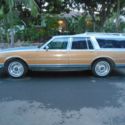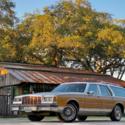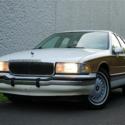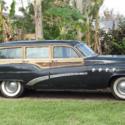1953 buick rodmaster Estate Wagon WOODY
- Price:
- Location: Kirkland, Washington, United States
- Condition: Used
- Make: Buick
- Model: Roadmaster
- SubModel: Woody
- Type: Wagon
- Trim: Roadmaster Estate WOODY
- Year: 1953
- Mileage: 110,000
- Color: Green
- Engine size: V8
- Number of cylinders: 8
- Transmission: Automatic
- Interior color: Two tone white & green
- Vehicle Title: Clear
1953 Buick Roadmaster Woody Description
This vehicle has been in storage for over 30 years and yes it does run and drive. The wood is in pretty nice shape, no chips or cracks, but it certainly needs some deep oiling treatment. The chrome is all in good shape and the interior is complete, in fact the car is complete with no missing parts that I am aware of. This is a great deal as these go for over $85,000 restored and there is not a lot to do but clean it up tune it up replace some old worn out suspension, treat the wood and polish the paint and it should be show ready.
The 1953 Roadmaster Estate Wagon, with all of its appealing elegance, exhibits a series of firsts and lasts for the Flint automaker. Newly developed 322-cu.in. V-8
Affectionately dubbed the "Nailhead" due to the design of its intake/exhaust valves, the traditional 90-degree V-8 featured a compact 4.00 x 3.20-inch bore and stroke, which helped reduce its dimensions--when compared to the straight-eight--by 13½ inches of length and four inches of height; it was also a svelte 26.56 inches wide, all contributing to a front-end weight savings of 180 pounds. Internally, a new piston design lent itself to a higher 8.5:1 compression ratio. Topped with a four-barrel carburetor, the new powerplant was rated for 188hp--18 more than the previous year--and 300-lbs.ft. of torque in the top-of-the-line Roadmaster. With the engine came a switch to a 12-volt electrical system.
In addition to the V-8, Buick further developed its automatic transmission. Beginning with the 1953 models, each Roadmaster came equipped with the Twin-Turbine Dynaflow standard, the redesign of which was said to increase torque output by 10 percent. It was still used in conjunction with the division's longstanding implementation of a torque-tube/differential system.
Although on the surface, it appears as though there were few changes to the body from 1952, the subtle differences are quite significant. On all but the four-door sedan, the Roadmaster was now assembled on a downsized chassis that measured 121.5 inches from front to rear hubs, with a reduction in overall body length to 207.6 inches. Minor annual changes to the trim continued, especially to the headlamp and taillamp configurations. Additionally, the compact V-8 also meant that designers could lower the profile of the hood, providing drivers and passengers alike a better view of the world in front of them.
 1990 Buick Woody Estate Wagon
1990 Buick Woody Estate Wagon
Mileage: 3,940
 1951 Buick Roadmaster Estate Wagon 59815 Miles Sharon Green Woody Wagon 320 cubi
1951 Buick Roadmaster Estate Wagon 59815 Miles Sharon Green Woody Wagon 320 cubi
Mileage: 59815
 1952 Buick Super Woody Estate Wagon
1952 Buick Super Woody Estate Wagon
Mileage: 76,593
 1994 buick roadmaster woody estate wagon
1994 buick roadmaster woody estate wagon
Mileage: 213986
 1948 Buick Roadmaster Estate Wagon Woodie Woody
1948 Buick Roadmaster Estate Wagon Woodie Woody
Mileage: 100,000
 1988 Buick LeSabre Estate Wagon W/3rd Row Seat 5.0 Litter Woody
1988 Buick LeSabre Estate Wagon W/3rd Row Seat 5.0 Litter Woody
Mileage: 72393
 1991 Buick Roadmaster Estate Wagon Station Woody Very clean ICE COLD A/C 5.7L V8
1991 Buick Roadmaster Estate Wagon Station Woody Very clean ICE COLD A/C 5.7L V8
Mileage: 158,493
 1992 Buick Roadmaster Estate 5.7L station wagon woody 92K miles NO RESERVE
1992 Buick Roadmaster Estate 5.7L station wagon woody 92K miles NO RESERVE
Mileage: 92,857
 1952 Buick Roadmaster "WOODY" Estate Wagon One Owner 100% Original Big As A Limo
1952 Buick Roadmaster "WOODY" Estate Wagon One Owner 100% Original Big As A Limo
Mileage: 108,191
 1994 Buick Roadmaster Woody Estate Wagon 3-rd ROW SEAT LEATHER NO RESERVE LOOK
1994 Buick Roadmaster Woody Estate Wagon 3-rd ROW SEAT LEATHER NO RESERVE LOOK
Mileage: 132,802











